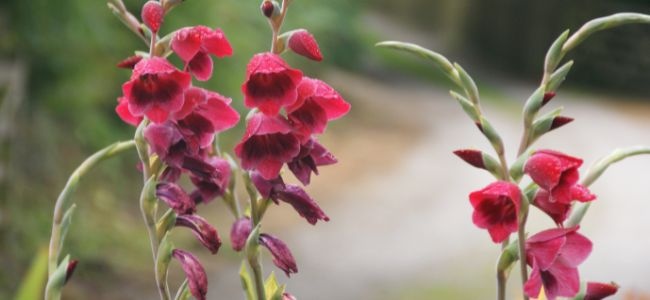-
0
Your Shopping Basket
0 ITEMS IN YOUR BASKET

Other South African Plants Growing Tips
 Gladioli
GladioliThe South African Gladioli that we offer are all hardy forms and can be left in the ground from year to year, provided the conditions are right. They flower in Summer and early Autumn bring colour to the garden in a light and delicate way (unlike the highly bred hybrid Gladioli grown for gardens and cut flowers).
Gladioli grow from corms which are bulb-like swollen ends to the stem. Each year, after flowering, a new corm forms on top of the old one which withers away.
They all prefer a sunny position, and well-drained soil. When planting in soil that is not already free draining, we suggest that you dig a hole deeper than required and add some grit at the base of the hole, this will help to drain the soil directly below the corms in the event of any prolonged wet weather.
You should aim to set the corms around 10cm (4”) deep, they will work their way closer to the surface over time but it’s better to start at this depth. And a layer of grit or bark on the surface will help to protect the corms from cold in winter and drought in a dry summer.
Feeding is not essential but a sprinkling of organic feed in early Spring will not go amiss.
The flowers are fairly self-supporting but Gladiolus papilio Ruby can sometimes become a little top-heavy so a cane will help. After flowering, do not cut back - the old foliage and flower stems usually pull away easily at the end of the year and you can gather seed from the seed heads if you wish.
Clumps will increase over the years as baby ‘cormlets’ form under the main corm, these can be left to grown on in the soil, or ‘sown’ into in small pots.
Tulbaghia
Tulbaghia are attractive bulbous perennials from South Africa that are members of the Allium family. They are grown for their pretty blooms in shades of pink, white and lilac in clusters atop stems.
When crushed, the narrow, pointed, fleshy leaves emit a garlic/onion fragrance – in South Africa they are chopped in cooking in the same way as Chives, earning Tulbaghia the name of ‘Society Garlic’.
I find them best grown in gritty compost in tall pots, their fleshy roots will soon fill the space. In early Spring, place in a sunny position, sheltered from the very worst frosts, and start watering and feeding (tomato food every 2 weeks is good). The leaves come first, then the flowering stems from early Summer. If you pinch out flower stems at the base when the flowers finish, this will prevent them going to seed and you should get flowers right through to late Autumn!
Over winter, keep the pots fairly dry and in a cold greenhouse or porch, it does not need to be totally frost free.
Tulbaghia can also be grown in a sunny, well-drained border with a grit mulch atop.




